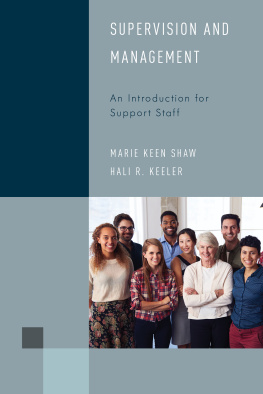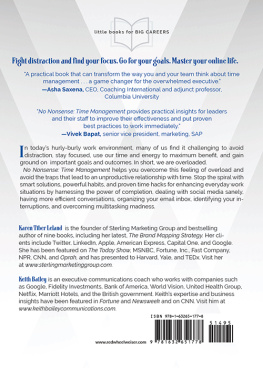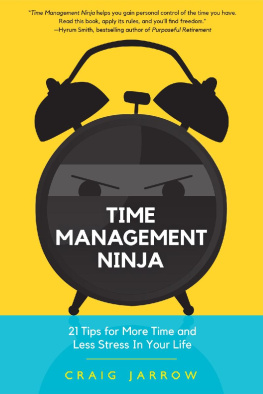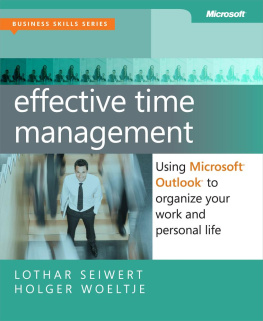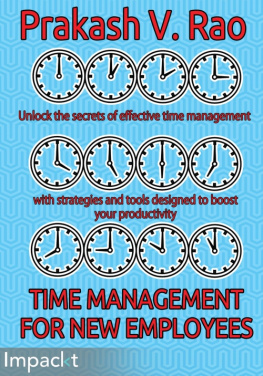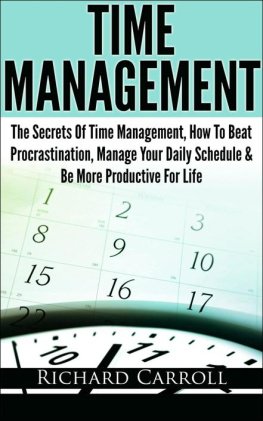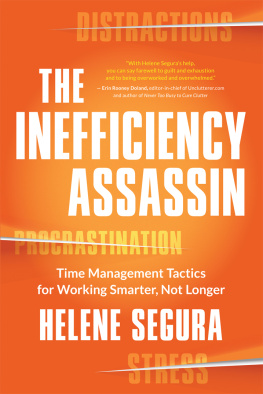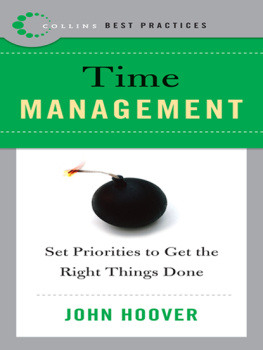Crash Course in Time Management for Library Staff
Recent Titles in Libraries Unlimited Crash Course Series
Crash Course in Children's Services, Second Edition
Penny Peck
Crash Course in Collection Development, Second Edition
Wayne Disher
Crash Course in Marketing for Libraries, Second Edition
Susan W. Alman and Sara Gillespie Swanson
Crash Course in Readers' Advisory
Cynthia Orr
Crash Course in Storytime Fundamentals, Second Edition
Penny Peck
Crash Course in Basic Cataloging with RDA
Heather Lea Moulaison and Raegan Wiechert
Crash Course in Weeding Library Collections
Francisca Goldsmith
Crash Course in Technology Planning
Christopher D. Brown
Crash Course in Library Budgeting and Finance
Glen E. Holt and Leslie E. Holt
Crash Course in eBooks
Michele McGraw and Gail Mueller Schultz
Crash Course in Contemporary Reference
Francisca Goldsmith
Crash Course in Young Adult Services
Sarah Flowers
Crash Course in Time Management for Library Staff
Brenda Hough
Crash Course
Copyright 2018 by Brenda Hough
All rights reserved. No part of this publication may be reproduced, stored in a retrieval system, or transmitted, in any form or by any means, electronic, mechanical, photocopying, recording, or otherwise, except for the inclusion of brief quotations in a review, without prior permission in writing from the publisher.
Library of Congress Cataloging in Publication Control Number: 2017046406
ISBN: 978-1-4408-5067-7 (paperback)
978-1-4408-5068-4 (ebook)
22 21 20 19 18 1 2 3 4 5
This book is also available as an eBook.
Libraries Unlimited
An Imprint of ABC-CLIO, LLC
ABC-CLIO, LLC
130 Cremona Drive, P.O. Box 1911
Santa Barbara, California 93116-1911
www.abc-clio.com
This book is printed on acid-free paper 
Manufactured in the United States of America
This book is dedicated to several people.
First of all, thank you to Lisa Barnhart and Mary Ross. This book would not exist if they had not first helped me create a course on the topic in 2012.
Next I would like to dedicate this book to moms and dads everywhere. I see you there, juggling and worrying and making things work, and you are amazing.
And finally, I express my love and thanks to my husband and son. To borrow from a Raymond Carver poem, what I want in this life is "to call myself beloved, to feel myself beloved on the earth." Because of you, Fred and Beckett, I do.
Contents
While I have probably always been a bit overly fond of my daily planner, my interest in time management turned to near obsession after my son was born. As I juggled the various roles I was playing in my personal and professional lives, it became clear that managing time was more than my time, but it involved the people around me. In my quest to manage projects and hours more effectively and gracefully, I not only discovered useful tools and strategies, but I also discovered that it was surprisingly fun to talk to other people about time management. Since that time, I have been presenting time management tools to audiences at conferences, workshops, and most recently for in a popular four-week course for Infopeople. This book introduces tools, hints, explanations, and suggestions to you, while encouraging you to pick and choose and devise a system that makes sense for you and your life.
introduces how to streamline your processes to become more effective. When you are more effective in the workplace, you feel on top of things rather than overwhelmed. In reality, it's not really time management that matters as much as energy management. Being aware of our energy levels and aware of our capacity can lead to success in managing our time.
We learned to tell time at a very early age, watching the classroom clock carefully as those hands moved to the magic time of recess and lunch and dismissal for the day. We learn the months of the year and the days of the week, but beyond those basic building blocks of time measurement, many of us never received formal training in time management.
introduces time logs and suggests keeping one at least for a short period of time. Tracking your time allows you to learn to realistically assess your actual usage of time. This can be done with pen and paper or with online tools. By analyzing a time log, you discover what you are actually doing so that you can determine and eliminate your potential time wasters.
Setting goals and priorities in both your professional and personal life is discussed in match your priorities?
What if you aren't doing what you want to be doing? What if the way you spend your time doesn't match your priority list? If there's a big disconnect between your priorities and your time usage, then you will always struggle with how you are using your time. You may be quite efficient but you may not feel happiness or a sense of accomplishment. This chapter helps you take a realistic look at your present goals and priorities can help you recognize ways in which your time does not match up with what is important to you. Before you end this chapter, you will rethink your goals and priorities, and, if necessary, set new ones.
introduces you to some very basic tools for time management beginning with how to create a "to-do" list both on pen and paper or online. Here is where you note the activities that are in the near and distant future, those things which you are responsible for doing or seeing that they are done.
Keeping a calendar is probably the most basic time management tool of all. It helps you make sure you don't miss a dental appointment, a team meeting, or the deadline for a grant proposal. Scheduling requires an awareness of when one can plan an event or hold a meeting.
In the book's discussion of time management strategies, the use of a timer is suggested for some tasks to help encourage focus. Setting the timer means working on the project for a specified length of time and then stopping with a return later.
The use of these tools is also helpful in learning to form helpful habits. What activities in your life can you make routine, so that you don't really even have to think about them?
involves "Getting Past Procrastination." Calendars and schedules outline what needs to be done, but things can slide for a variety of reasons. We may avoid a boring task or put off one that we're uncertain about how to begin.
Large projects may seem overwhelming and the desire to put off starting the task seems preferable to plunging right into step one. Or sometimes when a project is coming to an end, the final stages can be stressful causing you to want to set it aside. Or, perhaps you said "yes" once too often and you have too many things on your to-do list or you underestimated how much time any of your other tasks might take.
Getting over the desire for perfection is the focus of . Do you try too hard to be perfect in everything you do or do you expect perfection in others? Perfectionism can lead to burnout, an inability to start a project, stress, or an unwillingness to take risks or even complete tasks. This chapter explains the difference between excellence and perfectionism. It also encourages recognizing that there are times when striving for efficiency rather than perfection makes the most sense.


